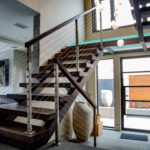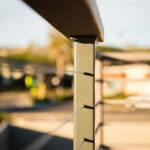Choosing the Right Cable Rail Fittings for Your Project
“Fittings”, “end hardware”, “tensioners” and “terminals” are all commonly used names for the stainless steel parts that terminate and tension cable runs. The quality and functionality of the fittings that are selected for each project will be an important safety factor. Additionally, properly selected cable rail fittings will ensure that re-tensioning or tune ups down the road will be simple and productive.
Function vs. Flare-
Years of field experience and feedback from contractors and installers have taught us a lot about cable hardware. When it comes to tension longevity or passing an inspection, we opt for functionality over flare. Trying to use the most concealed or low profile fittings may not always serve the project at hand. It’s important to remember that the individual technical factors of each job should dictate the fitting selection; not just the aesthetic considerations. Low profile and hidden fittings are sleek and attractive, however at times they offer little room for adjustment.
On several occasions our preferred installers have been called out to inspect and repair cable railings that are “slacked” or “loose”. Typically the fittings or assemblies have been purchased on “eBay” or some other retail or online outfits that just sell the products. The cables have malfunctioned because the fittings selected did not provide enough tension capability. Upon installation they may have seemed tight; yet over time or due to acclimation they became loose, and provided no room for future adjustment. Many times these cables must be cut and new fittings must be purchased and installed. At SDCR all of our DIY cable assemblies are designed with strength and longevity in mind. We are happy to recommend cabling and hardware specifically catered to the job.
Swaging vs. Crimping vs. Self Locking Fittings-
Swaging is the process of joining pieces of metal together. A “machine swage” is usually done by the manufacturer via a hydraulic press. A machine swaged fitting to cable connection functions like a cold weld and is the strongest way to join cable and fittings. Most often, one end of the cable assembly receives a machine swaged fitting. The other end will be completed in the field by hand crimping or utilization of a self locking fitting which allows the installer to cut and install at exact length.
Hand Crimped Fittings are installed in the field using a crimping tool which compresses the fitting on to the cable. Hand crimped cable rail fittings are the least expensive option; however crimping only provides about 70% of the strength of an actual swage. Crimping has been a cable rigging practice for decades and proven cost effective and durable. An approved cable crimping tool should always be used for architectural railing installations.
Most recently Self Locking Fittings have become popular due to the ease of installation, with no need for crimping or swaging tools. Users can cut their cables and insert them directly into the fittings in one direction, while pulling in the other direction causes the fitting to grab tighter and tighter as tension is applied. Self Locking Fittings carry a premium for the convenience with the highest price point; however for DIY installers it can be well worth the cost. Another added benefit for the DIYer is the ability to release the self locking fitting if necessary.
At San Diego Cable Railings we offer a large selection of cable rail fittings. Treating each project individually and assessing unique job factors, our pros can help you select the right hardware for the job. If you have questions about any of our DIY cable assemblies or stainless steel hardware; give us a call at 844-277-7327 (SDCR) or visit the quote request page.




